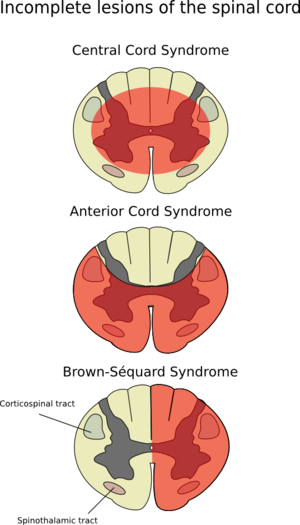Anterior Cord Syndrome: Difference between revisions
(Added Introduction, Added Headings) |
(added aetiology) |
||
| Line 1: | Line 1: | ||
== Introduction == | == Introduction == | ||
[[File:Incomplete Spinal Cord Injury.png|thumb]] | [[File:Incomplete Spinal Cord Injury.png|thumb]] | ||
Anterior cord syndrome referred to as Anterior spinal artery syndrome (ASAS) or ventral cord syndrome(VCS)<ref>Santana JA, Dalal K. Ventral Cord Syndrome. 2021 Aug 26. In: StatPearls [Internet]. Treasure Island (FL): StatPearls Publishing; 2021 Jan–.</ref>. ASAS is an incomplete [[Spinal Cord Injury|spinal cord injury]](SCI) that is often related to flexion injuries of the cervical region that result in infarction of the ventral two thirds of the cord and/or its vascular supply from the anterior spinal artery.Patients present with impairments | Anterior cord syndrome referred to as Anterior spinal artery syndrome (ASAS) or ventral cord syndrome(VCS)<ref>Santana JA, Dalal K. Ventral Cord Syndrome. 2021 Aug 26. In: StatPearls [Internet]. Treasure Island (FL): StatPearls Publishing; 2021 Jan–.</ref>. ASAS is an incomplete [[Spinal Cord Injury|spinal cord injury]](SCI) that is often related to flexion injuries of the cervical region that result in infarction of the ventral two thirds of the cord and/or its vascular supply from the anterior spinal artery.<ref>Deutsch JE, O’Sullivan SB. Stroke. In: O'Sullivan SB, Schmitz TJ, Fulk G, editors. | ||
Physical Rehabilitation.7th edition. Philadelphia: FA Davis; 2019. p.860</ref> Patients present with impairments in the pain and temperature sensations while the vibration and proprioception sensation is preserved. Motor deficits are observable both at and below the level of injury. | |||
== Clinically Relevant Anatomy == | == Clinically Relevant Anatomy == | ||
ASAS is caused by ischemia within the anterior spinal artery (ASA), which supplies blood to the anterior 2/ | ASAS is caused by ischemia within the anterior spinal artery (ASA), which supplies blood to the anterior 2/3rd of the spinal cord. The anterior spinal artery, with a few radicular artery contributions, supplies blood to the bilateral anterior and lateral horns of the spinal cord, as well as the bilateral [[spinothalamic tract]]<nowiki/>s and [[Corticospinal Tract|corticospinal tracts]]. The anterior horns and corticospinal tracts control the somatic motor system from the neck to the feet. The lateral horns span T1-L2 of the spinal cord and sheathe the neuronal cell bodies of the sympathetic nervous system. The spinothalamic tracts carry pain and temperature sensory information. | ||
== Aetiology == | |||
# Spinal cord crush injury | |||
# Epidural Hematoma related pressure injury | |||
# Hyperflexion injury in athletes (if bony instability) with herniation of dislocated vertebral body fragments or acutely herniated discs compressing the anterior spinal artery and spinal cord. | |||
# Anterior Spinal Artery compression with secondary cord ischemia. | |||
## Vascular disease-Aortic surgery or atherosclerotic disease as seen in the elderly<ref>Sandoval JI, De Jesus O. Anterior Spinal Artery Syndrome. 2021 Aug 30. In: StatPearls [Internet]. Treasure Island (FL): StatPearls Publishing; 2021 Jan–. </ref> | |||
## Cross-Clamping aorta<ref>Wagner R, Jagoda A. Spinal cord syndromes. Emerg Med Clin North Am. 1997 Aug;15(3):699-711. doi: 10.1016/s0733-8627(05)70326-6.</ref> | |||
== Mechanism of Injury == | == Mechanism of Injury == | ||
Revision as of 19:20, 30 December 2021
Introduction[edit | edit source]
Anterior cord syndrome referred to as Anterior spinal artery syndrome (ASAS) or ventral cord syndrome(VCS)[1]. ASAS is an incomplete spinal cord injury(SCI) that is often related to flexion injuries of the cervical region that result in infarction of the ventral two thirds of the cord and/or its vascular supply from the anterior spinal artery.[2] Patients present with impairments in the pain and temperature sensations while the vibration and proprioception sensation is preserved. Motor deficits are observable both at and below the level of injury.
Clinically Relevant Anatomy[edit | edit source]
ASAS is caused by ischemia within the anterior spinal artery (ASA), which supplies blood to the anterior 2/3rd of the spinal cord. The anterior spinal artery, with a few radicular artery contributions, supplies blood to the bilateral anterior and lateral horns of the spinal cord, as well as the bilateral spinothalamic tracts and corticospinal tracts. The anterior horns and corticospinal tracts control the somatic motor system from the neck to the feet. The lateral horns span T1-L2 of the spinal cord and sheathe the neuronal cell bodies of the sympathetic nervous system. The spinothalamic tracts carry pain and temperature sensory information.
Aetiology[edit | edit source]
- Spinal cord crush injury
- Epidural Hematoma related pressure injury
- Hyperflexion injury in athletes (if bony instability) with herniation of dislocated vertebral body fragments or acutely herniated discs compressing the anterior spinal artery and spinal cord.
- Anterior Spinal Artery compression with secondary cord ischemia.
Mechanism of Injury[edit | edit source]
Pathological process[edit | edit source]
Clinical Presentation[edit | edit source]
Diagnostic Procedures[edit | edit source]
Outcome Measures[edit | edit source]
Management/Interventions[edit | edit source]
Non-surgical[edit | edit source]
Surgical[edit | edit source]
Prognosis[edit | edit source]
Differential Diagnosis[edit | edit source]
- Central cord syndrome
- Dorsal cord syndrome
- Brown-Séquard syndrome
- Conus medullaris syndrome
- Cauda equina syndrome
- Transverse myelitis
- Guillain-Barré syndrome
- Multiple sclerosis
- Spinal epidural abscess
- Epidural hematoma
- Disk herniation
- Spinal cord neoplasm
- Meningitis/encephalitis
- ↑ Santana JA, Dalal K. Ventral Cord Syndrome. 2021 Aug 26. In: StatPearls [Internet]. Treasure Island (FL): StatPearls Publishing; 2021 Jan–.
- ↑ Deutsch JE, O’Sullivan SB. Stroke. In: O'Sullivan SB, Schmitz TJ, Fulk G, editors. Physical Rehabilitation.7th edition. Philadelphia: FA Davis; 2019. p.860
- ↑ Sandoval JI, De Jesus O. Anterior Spinal Artery Syndrome. 2021 Aug 30. In: StatPearls [Internet]. Treasure Island (FL): StatPearls Publishing; 2021 Jan–.
- ↑ Wagner R, Jagoda A. Spinal cord syndromes. Emerg Med Clin North Am. 1997 Aug;15(3):699-711. doi: 10.1016/s0733-8627(05)70326-6.







